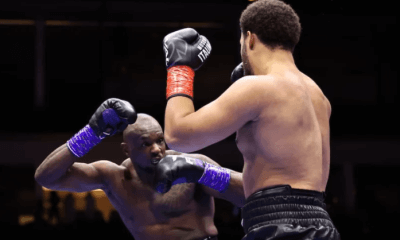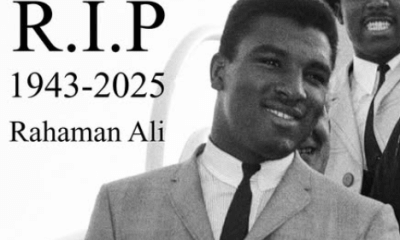Featured Articles
The Way of the Jackal: Reflections on Rigondeaux-Donaire
When Nonito Donaire left his corner to face Guillermo “El Chacal” Rigondeaux at the first bell, he took two steps forward and spread his legs. That was the first hint as to what he was in for. The Boxing Writers Association of America’s 2012 Fighter of the Year fought more like John “the Beast” Mugabi than the celebrated boxer-puncher he is. In failing to apply an intelligent strategy or a sustained attack, he was undone. The Jr. Featherweight throne, which is set above the belts and the nonsense by the Transnational Boxing Rankings Board, has been seized by a master counterpuncher.
That wide stance you saw Donaire assume in round one indicated primitive thinking. When Mugabi tried to seize the throne of Marvelous Marvin Hagler back in 1986, Mugabi stood pat as if to say “move me.” Hagler, his bald head steaming under Vegas lights, moved him.
Rigondeaux moved.
Standing a little over 5’4 and sporting a professional record shorter than that (Rigondeaux was 11-0 at fight time), he made the best argument yet for long apprenticeships in the amateur ranks (his amateur record is reportedly 243-4). He is a future participant in the best parade in boxing, a parade led by supreme stylists Joe Gans and Jack Britton, by Willie Pep and Pernell Whitaker, where banners flap in the wind and declare that the alpha asset in the ring is skill; and the more advanced it is, the better.
Their fan base is smaller than the bloodthirsty, balcony-busting Dempsey/Gatti crowd, but more urbane. Gil Clancy, the late Hall of Fame trainer and expert analyst for both Showtime and HBO was among them. His commentary during the Hagler-Mugabi broadcast can shine a light on Saturday night and reveal just how it was that Rigondeaux defeated Donaire.
“Marvin is moving the way he should move, he has to constantly move to his right and use that jab —make Mugabi reach for him.”
Hagler’s right jab was designed to stunt Mugabi’s offense. Rigondeaux’s jab was used more as a distraction. He shot it out like he was shadow boxing, at times tapping Donaire’s glove like an amateur taps an opponent’s headgear for points. Its purpose was to entice a counter from Donaire to counter that counter just so. In round four, he half-extended his jab like an old-school fighter from the 1900s. That was also an enticement.
Rigondeaux, a southpaw like Hagler, did not move to his right as Clancy would have expected. He moved to his left, though with a purpose. He knows to move to his right and has in previous bouts against orthodox fighters, but he made a tactical adjustment against Donaire. Why? Gil Clancy has the answer.
“We always say a left hook is the way to beat a southpaw, and Mugabi’s got a vicious left hook.”
Donaire’s own vicious left hook sent Jorge Arce into an electric boogie. Rigondeaux was aware of the danger enough to break with tradition. More concerned about Donaire’s left hook than his right hand; he moved to his left to circle away from it. He didn’t do it without thumbing his nose now and then: In the first round he shifted to his left, and as he went, he landed a right hook. Donaire’s counter left hook fizzled behind him.
Rigondeaux also changed directions, suddenly and just as easily, to his right. In a laudable demonstration of boxing improv, he slid to his right off a right hook. (It is the same principle a certain writer uses when climbing out of his Camaro. He swings a leg to the pavement, places an elbow at the egress, spins out, and hopes no one notices.) When Donaire tried to counter the right hook with a left hook, Rigondeaux would merely dip his head under it while sliding away.
“…Mugabi is allowing Hagler to move the way he wants to move.”
Donaire was allowing Rigondeaux to move the way he wanted to move. He waited like a stationary bike in a bedroom, like a monument to fizzled intentions. What was he waiting for? Donaire, a natural counterpuncher like Rigondeaux, was waiting for a mistake to capitalize on. He got a sum total of one. When Rigondeaux got tangled up with him in the tenth round, he stood square long enough for Donaire to wing a left that knocked him off balance and to the canvas. But then, even Michelangelo got paint in his eyes during his own exertions.
Rigondeaux was allowed the freedom to experiment during the bout. In the first round, he fought on a dime at mid-range to find counters and send messages. Those one-twos were warnings about what was coming if Donaire got fresh. By the second round, he had moved outside, specifically, just off the perimeter (i.e., just out of reach), to set bait with dummy jabs and loose hooks. Donaire was constantly forced to turn and reset. He was mesmerized by mobility and wary with the memory of an overhand left that landed in the first round. His beastly posture remained, even if he was tamed.
“It’s the pattern of the fight that counts…”
Rigondeaux finished the fight as if he had just finished a brisk walk in Central Park. Except for two significant punches landed by Donaire —both of them unorthodox and therefore not detected by advanced radar— Rigondeaux emerged unscathed. This demands a closer look.
How did a man with a preference for fighting off the back-foot tame a beast? Despite his own sense of being wronged by elements far beyond boxing, Rigondeaux does not fight with the righteous rage that motivated Marvin Hagler. Where Hagler was willing, Rigondeaux is not. “He seen me still smiling,” Hagler said about a Mugabi blast. “I like that kind of stuff. I love a good fight.” Rigondeaux fights like someone suffering from chiraptophobia, and yet managed to convince Donaire that his aggression would be punished.
Rigondeaux’s offense was triggered by Donaire feints and posturing as much as by his assaults. When Donaire thought he saw a bull’s eye, Rigondeaux would read his intentions and respond. In rounds four and six, Donaire found it within him to mount an attack, though was surprised when Rigondeaux finished the exchanges with an exclamation point. There was something else that surprised Donaire: Rigondeaux’s defensive aptitude was actually elevated during heated exchanges. The pattern was almost invariable: Under fire, Rigondeaux grits his teeth. He gets low, feints a shot with one hand while moving in to shoot his other hand, and then dips his head as he slides off to a safe angle. Donaire could only miss, absorb a shot flush to the face, and then miss again.
With his left hook neutralized early and his head bouncing backwards by counter shots designed to teach him a lesson, Donaire began acting in a way that a behaviorist might call learned helplessness. He seemed to believe the counterpuncher in front of him was doing him a favor by remaining in a defensive posture, by sparing him from Hagler-like ferocity. And in a gesture of appreciation, he ignored his corner’s pleas to pressure Rigondeaux. He willingly lost eleven of twelve rounds because the jackal was not worth provoking. The jackal had broken his spirit.
It was an anti-climactic championship bout—the kind that brings groans from the Dempsey-Gatti crowd— but it was, said Rigondeaux, an exhibition of skill for “the people who know boxing”; like Gil Clancy.
As for the vanquished, he called the new king’s performance “…beautiful…”
______________________________________
Springs Toledo can be contacted at scalinatella@hotmail.com.
-

 Featured Articles4 weeks ago
Featured Articles4 weeks agoThe Hauser Report: Zayas-Garcia, Pacquiao, Usyk, and the NYSAC
-

 Featured Articles3 weeks ago
Featured Articles3 weeks agoOscar Duarte and Regis Prograis Prevail on an Action-Packed Fight Card in Chicago
-

 Featured Articles2 weeks ago
Featured Articles2 weeks agoThe Hauser Report: Cinematic and Literary Notes
-

 Book Review2 weeks ago
Book Review2 weeks agoMark Kriegel’s New Book About Mike Tyson is a Must-Read
-

 Featured Articles4 weeks ago
Featured Articles4 weeks agoRemembering Dwight Muhammad Qawi (1953-2025) and his Triumphant Return to Prison
-

 Featured Articles7 days ago
Featured Articles7 days agoMoses Itauma Continues his Rapid Rise; Steamrolls Dillian Whyte in Riyadh
-

 Featured Articles3 weeks ago
Featured Articles3 weeks agoRahaman Ali (1943-2025)
-

 Featured Articles3 weeks ago
Featured Articles3 weeks agoTop Rank Boxing is in Limbo, but that Hasn’t Benched Robert Garcia’s Up-and-Comers













